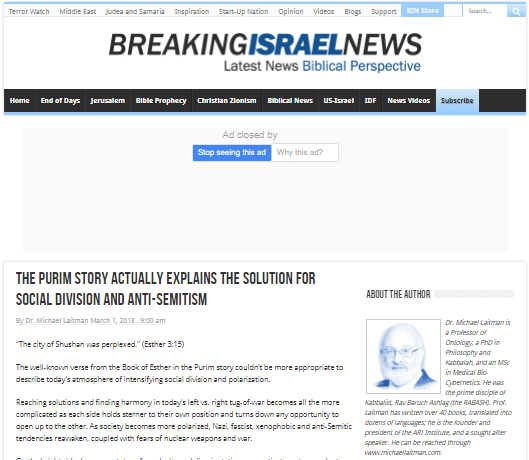
“The city of Shushan was perplexed.” (Esther 3:15)
The well-known verse from the Book of Esther in the Purim story couldn’t be more appropriate to describe today’s atmosphere of intensifying social division and polarization.
Reaching solutions and finding harmony in today’s left vs. right tug-of-war becomes all the more complicated as each side holds sterner to their own position and turns down any opportunity to open up to the other. As society becomes more polarized, Nazi, fascist, xenophobic and anti-Semitic tendencies reawaken, coupled with fears of nuclear weapons and war.
On the bright side, however, states of perplexity and disorientation can motivate us to reevaluate our life’s leading values. The growing left vs. right rift is an outcome of developing according to our base instincts, where we each seek comfort, security and reassurance as part of our closest families and tribes. The uncertainty and anxiety pervading modern society could just be the step we need in order to revise the way we’re going about our lives. Maybe we can use the mounting pressure to prod us into seeking common points of agreement and cooperation, and start rebuilding our lives on a new consensual basis?
The Purim story describes the near-genocide of the Jewish people.
Haman recognized the Jews’ division as an opportunity to eradicate them. “There is a certain people scattered abroad and dispersed among the peoples” (Esther 3:8). Haman said that in his view, the Jews would be able to be destroyed because they were separated from one another.
However, Mordechai, the hero of the Purim story, worked to bridge the Jews’ division, which is what eventually saved their lives: “the Jews gathered themselves together to stand for their life” (Esther 8:11).
Purim is as significant for Jews today as it was for the Jews in the story itself. Also, it holds immense importance for society at large. A major aspect that needs to be understood about the meaning of Purim in order for us to understand its modern relevance is in relation to Haman: Who or what is Haman in our present times? That is, who or what is behind society’s increasing estrangement and polarization?
The immediate response according to our primal instincts is to personify the blame, that a President, or a group of politicians, financiers, executives or other conspiratorial schemers are behind our woes. However, beyond the face-value finger pointing, what is really behind all the social division is the divisive mindset that Haman represents: the desire to seek money, honor, control and/or power in spite of everyone and everything. This divisive mindset shuts us off from each other, separating us, harming us and masking the damage we do to each other.
Today’s tumultuous social atmosphere is a calling for us to seek our common voice as a humanity that shares common values and purpose. If we use this calling to connect a little above our primal instincts, then we can create a much more peaceful and friendly society for us all.
Whenever the Jewish people were at risk of ruin, it was our unity that saved us. We can use the Purim story as an eternal reminder that our unity can get us out of the worst situations, and that by uniting, we set a constructive and positive example for the rest of humanity.
Although we Jews have an innate commitment to set the standard for choosing unity over division, people of all races, colors, shapes and sizes should ideally make the same strides toward unification before heading into greater turmoil and crises. Our destiny is in our hands.
Featured in Breaking Israel News (BIN)